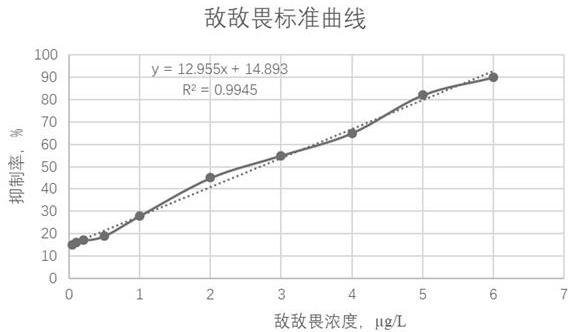Rapid detection method special for pesticide residues of dichlorvos in fresh fruits and vegetables
A technology for dichlorvos and pesticide residues, applied in the field of rapid detection of pesticide residues, which can solve problems such as difficult special detection
- Summary
- Abstract
- Description
- Claims
- Application Information
AI Technical Summary
Problems solved by technology
Method used
Image
Examples
Embodiment 1
[0027] Embodiment 1: Synthesis of fluorescent probe substrate formula-1
[0028] synthetic route:
[0029]
[0030] Synthesis of intermediate b: Weigh 2.00g fluorescein a, 1.71gCs 2 CO 3 , add 10mL DMF to dissolve, stir at room temperature, add dropwise 0.75g (0.75mL) CH 3 I. After the reaction, 5% sodium hydroxide solution was added, extracted with DCM, the organic phase was washed with saturated brine, and the solvent was evaporated to obtain 1.55 g of intermediate b, with a yield of 71.4%. 1 HNMR (500MHz, CDCl 3 ) δ 8.24 (d, J =7.9Hz,1H),7.74(t, J =7.2Hz,1H),7.67(t, J =7.6Hz,1H),7.31(d, J =7.5Hz,1H),6.97(d, J =2.3Hz,1H),6.87(dd, J =18.1,9.3Hz,1H),6.74(dd, J =8.9,2.3Hz,1H),6.54(d, J =9.7Hz, 1H), 6.47(s, 1H), 3.92(s, 2H), 3.64(s, 1H).
[0031] Synthesis of intermediate c: take intermediate b0.800g, add 20mLCH 3 OH, 5mL of 10% NaOH solution, stirred at room temperature for 6h for hydrolysis. After methanol was distilled off, it was neutralized with 10 mL (3...
Embodiment 2
[0033] Embodiment 2: Extraction method of pesticide residues in fruits and vegetables:
[0034] For the edible parts of vegetables and fruits, weigh 0.3g of the sample into a 2mL centrifuge tube, add 1.5mL of extract (ethyl acetate / acetone=9:1), and extract in a vibrating mixer for 5min. After centrifugation, take 100 μL of the supernatant to a 2 mL centrifuge tube and blow dry. Add 0.6mL LPBS (100mM, pH = 7.4) to dissolve, to be tested.
Embodiment 3
[0035] Example 3: General method for pesticide residue detection
[0036] 1. Take 6µL of the 0.6mL extractant to be tested (or PBS solution spiked with pesticides, or PBS solution) prepared in the pretreatment, and then dilute 100 times with PBS (100mM, pH=7.4) to 600µL;
[0037] 2. Add 5 µL of enzyme agent (extracted from duck blood, AChE protein content 2.3 mg / ml) to 300 µL of the diluted extract, and mix in a constant temperature mixer at 37 o C, pre-incubation reaction 7min;
[0038] 3. Take 300 µL of the pre-incubation solution, add it to a cuvette, and then add 30 µL of DMSO solution containing a fluorescent probe (not specifically referred to as the fluorescent probe of Formula-1), and put it in a constant temperature mixer at 37 o C, shock reaction for 12 minutes;
[0039] 4. Add 200µL Terminator B to the cuvette, mix well, and test;
[0040] 5. Start the fluorescence detector and link with the mobile APP; according to the different fluorescent probes, set the corre...
PUM
 Login to View More
Login to View More Abstract
Description
Claims
Application Information
 Login to View More
Login to View More - R&D
- Intellectual Property
- Life Sciences
- Materials
- Tech Scout
- Unparalleled Data Quality
- Higher Quality Content
- 60% Fewer Hallucinations
Browse by: Latest US Patents, China's latest patents, Technical Efficacy Thesaurus, Application Domain, Technology Topic, Popular Technical Reports.
© 2025 PatSnap. All rights reserved.Legal|Privacy policy|Modern Slavery Act Transparency Statement|Sitemap|About US| Contact US: help@patsnap.com



